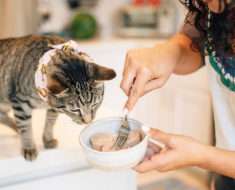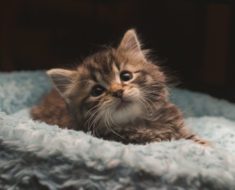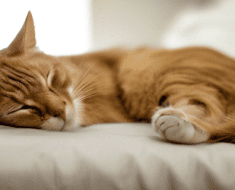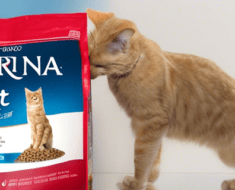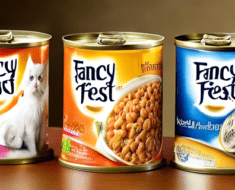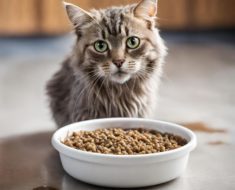An average adult cat requires about ¼ to ⅓ cup of dry food per meal. Feed your cat twice a day for optimal health.
Choosing the right amount of dry food to nourish your cat is crucial for its well-being. Cats typically need a balanced diet that suits their age, activity level, and health. Proper nutrition keeps them energetic and maintains their weight at a healthy level.
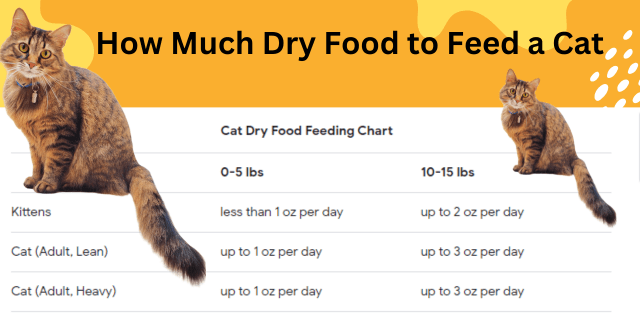
It’s essential to consult with a veterinarian to get personalized advice for your cat’s dietary needs. The feeding amount can vary significantly based on factors like metabolism, size, and whether the cat is indoor or outdoor. The quality of the dry food also plays a significant role, as higher-calorie foods may require smaller portions. Always ensure fresh water is available, and monitor your cat’s weight and body condition regularly to adjust feeding amounts as necessary.
Understanding the right amount of dry food for your cat starts with “Decoding Feline Nutrition.” Cats have specific dietary needs. It is vital to feed them correctly to help them live a long, healthy life.
The Importance Of A Balanced Diet For Cats
Cats rely on
just the right balance of nutrients to stay healthy. A balanced diet supports a cat’s overall well-being. This includes their coat, energy levels, and bodily functions.
- A precise amount of protein helps in muscle repair and growth.
- Fats provide energy and support a shiny coat.
- Carbohydrates offer a quick energy source, despite cats needing less.
- Vitamins and minerals boost the immune system and prevent disease.
High-quality
dry cat food should contain several important nutrients.
| Protein |
Maintains healthy muscles. |
| Fats |
Provides energy and supports skin and coat health. |
| Fiber |
Aids in digestion, helping with hairball control. |
| Taurine |
An essential amino acid important for heart and eye health. |
| Water Content |
Though dry food is low in water, the right amount is crucial for preventing dehydration. |
To determine the perfect portion size, consult with a vet. They can assess your cat’s specific needs. Remember, each cat is unique. Factors like age, weight, and activity level influence the right amount.
Look for dry foods with
high-quality protein and
limited fillers like grains and by-products. Always ensure fresh water is available to complement the dry food. Proper nutrition keeps your cat healthy, playful, and content.
Age Matters: Portion Sizes For Every Life Stage
Age Matters: Portion Sizes for Every Life Stage is critical when it comes to feeding your feline friend. Cats have different nutritional needs as they grow and age. The right amount of dry food can keep them healthy at each stage of life.
Kittens: Growing Bodies, Growing Needs
Kittens are bundles of energy with high nutritional demands. Feed them:
- 1/4 to 1/2 cup of dry food split into 3-4 meals daily.
- Adjust amounts based on growth and activity levels.
Free-feed is an option for continuous access to food, ensuring kittens grow strong and healthy.
Adult Cats: Maintaining Health
Adult cats require a balanced diet to maintain their health. Provide:
- 1/2 cup of dry food per day.
- Divide this into two meals – morning and evening.
Monitor weight regularly and adjust portions accordingly to avoid overfeeding.
Seniors: Adjusting For Slower Metabolism
Senior cats need fewer calories due to less activity. For seniors:
- Reduce dry food to 1/3 cup per day.
- Consider low-calorie food to prevent weight gain.
- Consult your vet to cater to health needs.
Cat Size And Weight Considerations
Determining the right amount of dry food for a cat involves careful consideration. Each cat is unique. Differences in size and weight play critical roles in how much food your furry friend needs. Here’s how to tailor your cat’s food portions to their specific requirements.
Small Vs. Large Breeds
Cat breeds vary widely in size. Small breeds, like the Siamese, naturally need less food. In contrast, larger breeds, such as Maine Coons, require more nourishment to maintain their health. Consider your cat’s breed size when measuring out their food.
Assessing Your Cat’s Body Condition
It’s crucial to assess your cat’s body condition regularly. Use a simple hands-on test. Feel for your cat’s ribs and spine. You should be able to find them without excess pressure.
- If ribs are easily felt, your cat may need more food.
- If you cannot feel the ribs, consider reducing their portions.
A vet can provide a more thorough body condition assessment. They can also guide you with a customized feeding plan for your pet.
The Role Of Weight In Determining Portions
Weight determines daily food portions. An overweight cat needs a calorie restriction to shed unwanted pounds. An underweight cat may require additional calories. Balancing your cat’s diet is key.
Here’s a general guide to daily feeding amounts based on weight:
| Weight of Cat |
Dry Food Per Day |
| 5 pounds (2.3 kg) |
30-40 grams |
| 10 pounds (4.5 kg) |
60-70 grams |
| 15 pounds (6.8 kg) |
80-100 grams |
Remember to adjust these amounts based on your cat’s activity level and body condition. Consult your vet for personalized advice.
Calculating The Right Amount
Knowing exactly how much dry food to offer your cat is essential for their health. Overfeeding can lead to obesity while underfeeding might not meet their daily needs.
Calculating the Right Amount is not a one-size-fits-all formula. It involves understanding food labels, measuring food portions accurately, and starting with feeding guides. This guide will help cat owners serve the perfect portion every time.
Reading And Interpreting Food Labels
Dry
cat food packages come with nutritional labels. These provide crucial information about the ingredients, calorie content, and serving suggestions based on weight. Start by
identifying your cat’s caloric needs.
- Find the ‘Guaranteed Analysis’ section for protein, fat, and moisture percentages.
- Check the ‘Caloric Content’ to assess kilocalories per cup or gram.
- Match your cat’s weight to the recommended serving size.
Measuring Food Portions Accurately
Accuracy is key when serving your cat’s food to prevent over or underfeeding. Use a
standard measuring cup and precisely fill it to the mark. If the recommendation calls for half a cup, fill to that exact point.
- Measure each serving with a standard cup.
- Level the cup to ensure the amount is accurate.
Keep serving sizes consistent with each meal to maintain a routine.
Using Feeding Guides As A Starting Point
Feeding guides provide a baseline for how much food to give, but they are not absolute. Align the guide with your cat’s
age, activity level, and health status. Kittens, active adults, and seniors may require different food amounts.
| Cat’s Age |
Activity Level |
Recommended Starting Portion |
| Kitten |
High |
⅓ to ½ cup |
| Adult |
Moderate |
¼ to ⅓ cup |
| Senior |
Low |
¼ cup |
Remember, these are starting points. Adjust the serving size to maintain
optimal health and weight.
Tweaking The Diet For Specific Needs
Tweaking the Diet for Specific Needs ensures your feline friend gets the right amount of nutrition. Cats have unique lifestyles and health requirements. Your cat’s diet must cater to these for their best health and happiness. Let’s understand how to adjust your cat’s dry food intake for their specific needs.
Accommodating Active And Indoor Lifestyles
Felines with different activity levels have varying calorie needs. An active cat loves to play and will need more food. A cat who prefers lounging may require less. Look at the examples below to balance their diet.
- Active Cats: Might need 20% more food than average.
- Indoor Cats: Often need 20% less food to prevent weight gain.
Special Dietary Requirements
Some cats need special diets due to health issues. It’s important to listen to your vet. They might recommend special food which could be more or less filling than standard dry food. You will have to watch how much your cat eats.
| Condition |
Food Type |
Portion Adjustment |
| Allergies |
Hypoallergenic |
Follow vet’s advice |
| Obesity |
Weight control |
Reduce portions gradually |
| Diabetes |
Low-carb |
Monitor, adjust as needed |
Adjusting Food Portions For Spayed Or Neutered Cats
Fixing your cat changes their metabolism. They’ll often need less food than before. Not adjusting their diet can lead to weight gain. Reduce their portions by about 25% post-surgery. Watch their weight and adjust from there.
- Spayed females often burn fewer calories.
- Neutered males experience a slower metabolism.
The Human Factor: Feeding Habits And Practices
The Human Factor: Feeding Habits and Practices play a pivotal role in determining a feline’s health. Choices made by cat owners regarding meal times and portion sizes have a direct impact on their pet’s well-being. Understanding the balance between a cat’s nutritional needs and feeding methodologies contributes to a healthy diet regime.
The Impact Of Free Feeding
Free feeding is leaving food out for a cat to eat anytime. This method seems convenient but poses certain risks:
- Inactivity and weight gain: Cats may eat more than needed, leading to obesity.
- Stale food: Kibble left out might lose freshness and attract pests.
- Difficult monitoring: It’s harder to track how much the cat actually consumes.
Scheduled Meals Versus Ad Libitum
When deciding between scheduled meals and ad libitum (all-day access to food), consider these points:
| Scheduled Meals |
Ad Libitum |
| Promotes routine and discipline. |
Offers constant food access. |
| Helps in weight management. |
May lead to overeating. |
| Allows monitoring of diet. |
Requires less monitoring. |
Avoiding Overfeeding And Obesity
Overfeeding is a common issue among cat owners. Here’s how to prevent obesity:
- Measure portions: Use a dedicated scoop or scale for accuracy.
- Check calorie intake: Refer to food labels and your vet’s advice.
- Regular exercise: Engage your cat in play to burn calories.
Keeping your cat active and sticking to appropriate portion sizes ensures a healthier life.
Monitoring And Adapting Food Intake
Determining the right amount of dry food for your cat is critical for their health. Monitor your feline’s weight and activity level to adapt their diet accordingly, ensuring a balanced nutritional intake.
Feeding your cat the right amount of dry food is crucial
for their health. Just like us, cats need
proper nutrition to stay healthy and happy.
Balancing their diet involves monitoring and
adapting their food intake.
This task can be challenging. Cats have different needs based on
age, size, and activity level. Let’s explore how you can
ensure your cat’s diet is as
perfect as they are!
Regular Weigh-ins And Health Checks
Keeping track of your cat’s weight is essential.
Regular weigh-ins prevent obesity and identify potential health issues.
- Place a scale in a quiet area.
- Weigh your cat monthly.
- Note the changes and patterns.
Annual health checks with your vet are also important. They ensure your cat remains in
tip-top shape.
Knowing When To Adjust Food Portions
Your cat’s food portions may need to
change over time.
Look for clues:
- Excess weight gain means it’s time to reduce portions.
- Sudden weight loss could require more food or a vet check-up.
Monitor your cat’s behavior and body condition closely.
Interacting With Your Veterinarian For Dietary Advice
- Choosing the right food for your cat’s life stage.
- Calculating accurate portion sizes based on health and lifestyle.
- Addressing specific dietary needs and concerns.
Frequently Asked Questions On How Much Dry Food To Feed A Cat
Is 1 Cup Of Dry Food Too Much For A Cat?
Serving 1 cup of dry food can be excessive for a cat, as portion size depends on their size, age, and activity level. Consult your veterinarian for personalized feeding advice.
How Much Dry Food Should I Feed My Cat Chart?
An adult cat needs approximately 1/4 to 1/2 cup of dry food daily. Adjust amounts based on the cat’s activity level and weight. Always consult your vet for personalized feeding advice.
How Many Bowls Of Dry Food Should A Cat Eat A Day?
An adult cat typically needs 1/4 to 1/2 cups of dry food daily, split into two meals. Adjust according to your cat’s age, weight, and activity level. Always consult with your vet for personalized feeding advice.
How Much Cup Of Dry Food Should I Feed My Cat?
Typically, feed an adult cat about 1/3 to 1/2 cup of dry food per day. Adjust amounts based on the cat’s activity level, health, and size. Always consult your vet for personalized advice.
What Determines Cat’s Dry Food Portion?
A cat’s age, weight, activity level, and health status dictate the portion size of dry food recommended by vets and food guidelines.
Conclusion
Determining the right amount of dry food for your cat depends on several factors. Age, weight, activity level, and health all play roles. Consult with your vet to tailor feeding to your feline’s needs. A balanced approach ensures a happy, healthy pet.
 It’s essential to consult with a veterinarian to get personalized advice for your cat’s dietary needs. The feeding amount can vary significantly based on factors like metabolism, size, and whether the cat is indoor or outdoor. The quality of the dry food also plays a significant role, as higher-calorie foods may require smaller portions. Always ensure fresh water is available, and monitor your cat’s weight and body condition regularly to adjust feeding amounts as necessary.
It’s essential to consult with a veterinarian to get personalized advice for your cat’s dietary needs. The feeding amount can vary significantly based on factors like metabolism, size, and whether the cat is indoor or outdoor. The quality of the dry food also plays a significant role, as higher-calorie foods may require smaller portions. Always ensure fresh water is available, and monitor your cat’s weight and body condition regularly to adjust feeding amounts as necessary.
